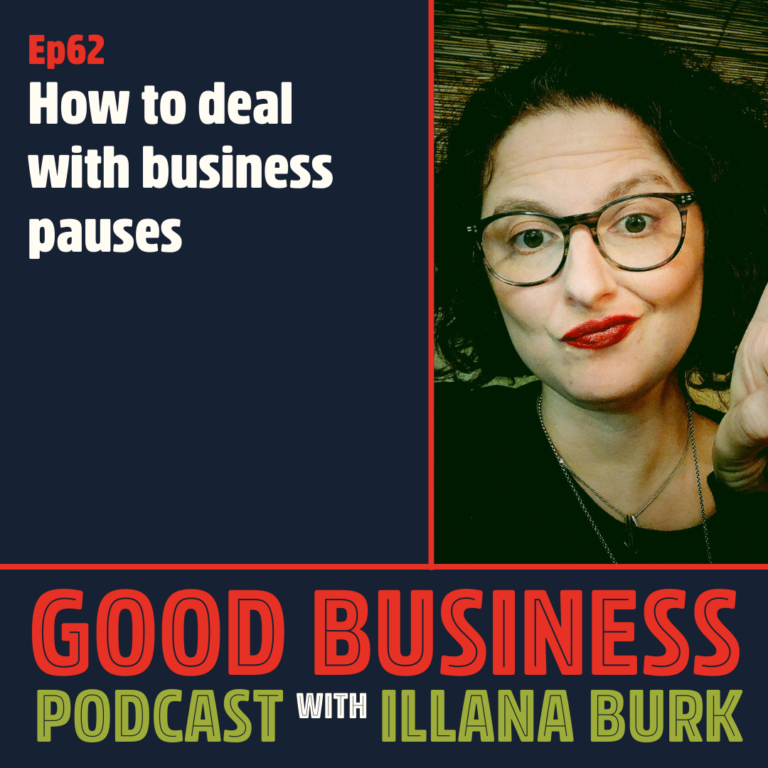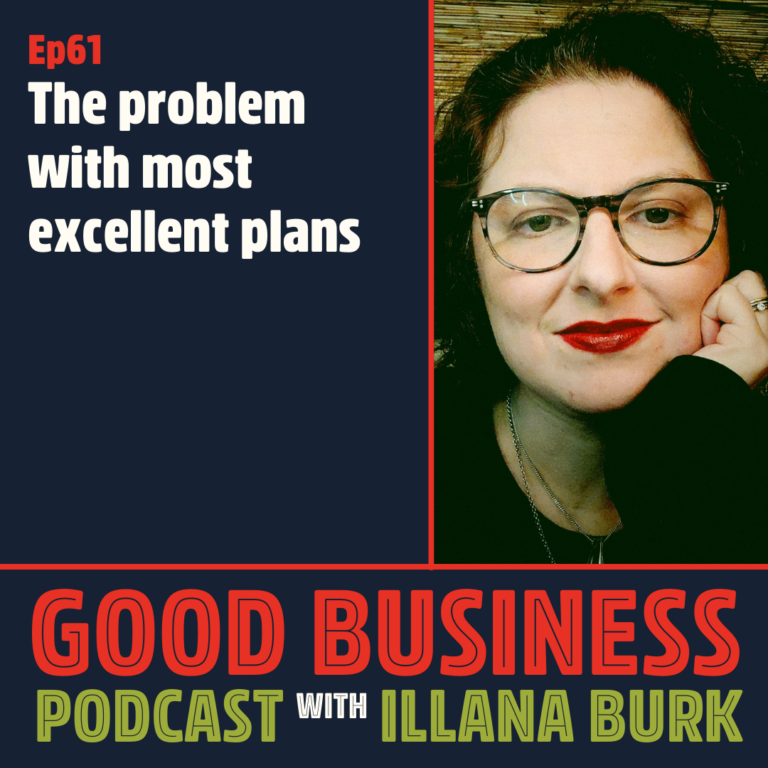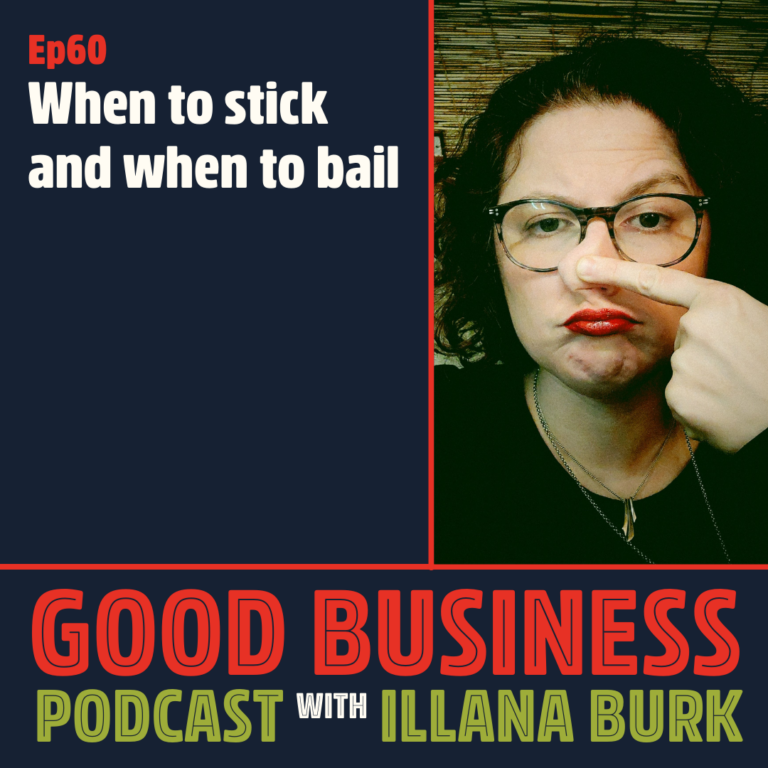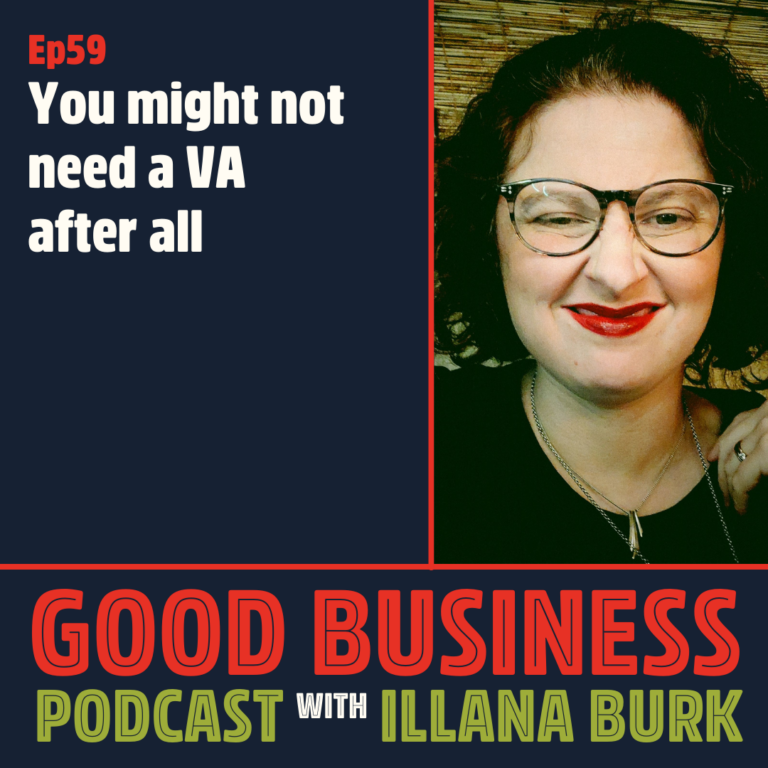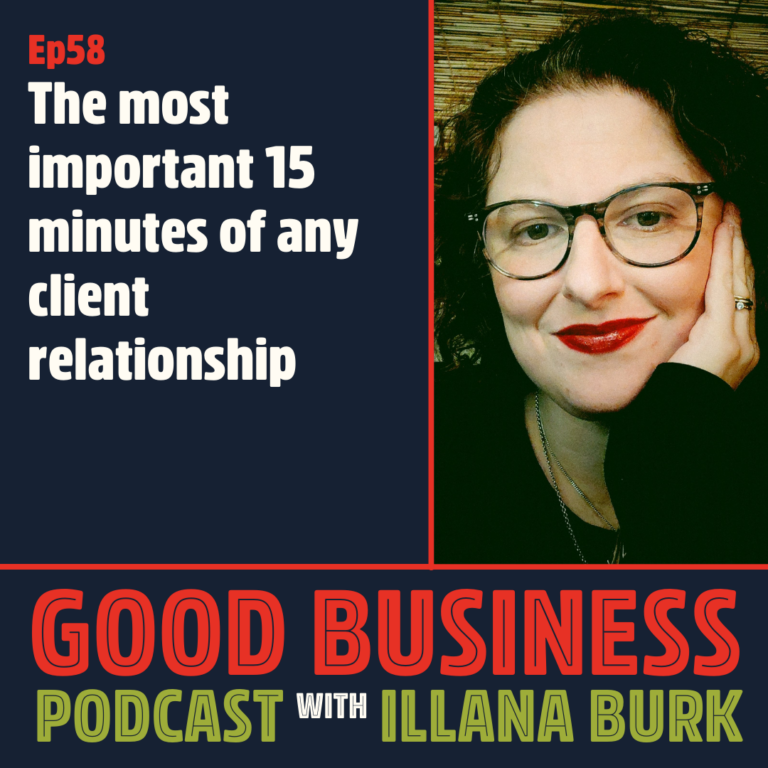Today, we’re going to talk about how to bring it all home. This is a pretty straight forward closing.
Episode Transcript:
Welcome back to The Good Business Podcast. I’m your host Illana Burk. And today we are wrapping up our three part series on how to do an amazing consult.
In our first episode, we talked about how to do a really solid opener. If you didn’t listen to that, that’s the most important one. So go back and listen to that one too, where we talk about how to set the tone for empathy, how to put people at ease, how to make sure that they are clear in their purpose, and feel calm enough to actually hear what you have to say.
In the second episode, we talked about why it’s really important to ask probative questions and give away your best stuff in the meaty part of the conversation in the middle part.
Today, we’re going to talk about how to bring it all home. This is a pretty straight forward closing.
Most people look at the end of a consult like a sales close. How do you ask for the sale?
I recommend doing the opposite of this. Simply don’t.
There’s an art to this. The thing is most people are really freaking tired of being sold to. Selling is not all that hard. It’s actually relatively easy and straightforward to manipulate people, if you don’t actually care about how you make them feel.
So closing is something that all it takes is skill. If you don’t care about other people. If you do care about other people, like I do, like most of you do, I would assume, or you wouldn’t have hung in with me this long, then paying really close attention to what people actually want and need, and offering an opportunity for agency, as a closing methodology, is a powerful pattern- interrupter.
As I mentioned on the first episode, I tell people right up front that I am not going to sell them at the end. They are not going to be pitched to. They’re not going to have an arm twisted. They’re not going to be backed into a corner.
We’re going to go through all the details of what their options are, and then I’m going to tell them to go away and think about it. So here’s the part where you keep that promise. Chances are, if you’ve done part one and part two really effectively. They’re going to be really ready to sign up. And they’re going to say that they’re ready to sign up.
The kicker here, and this is really important, is to tell them no.
And I know that sounds really counterintuitive. There is actual sales psychology to this. In yucky selling, they call this the takeaway where you say, I know you want something, but you can’t have it. There’s psychology to that. The more you tell somebody they can’t have something the more they want it.
That, however, is not why we’re doing this. That is just a by-product of doing this. We’re doing this because if you’ve done part one and part two really well, then the person sitting across from you is a little bit high. That’s not about ego. It’s just an objective truth. When you’ve offered someone a refreshing and different approach than they’ve ever experienced before, and they desperately need what you’re selling and you are really legitimately a good fit, they are going to be a little bit high at the prospect of having found it. So the more fresh your information is, the more empathetically you deliver it, the more ready they will be. And the more willing they will be to sacrifice good decision-making.
This is the key.
I have a firm policy in my business that if you can’t afford my intro fee, then I won’t let you put it on a credit card. I would rather spread it out over payments and have you begin a little bit later. I would rather find a way to offer a scholarship to make it more affordable. I will not, however, let somebody pay 28% to begin working with me, which would put them behind the eight ball before we ever even start. That’s an ethical line I simply won’t cross.
When someone’s super high and super excited to work with me, telling them that they cannot say yes right now, until they have engaged with the people they most care about, be that spouse, cat, I don’t care. They need buy-in. They need the buy-in of the people around them. They need to feel good about how they express it.
They need to be able to articulate the value of working with me. Or they shouldn’t be doing it. They need to do that independently of me. I want them to go away and think about it. I want them to put up objections. In themselves. Because I know for sure that if they don’t do it now, they will do that later when they’re irritated or frustrated with some part of the process of working with me.
And that will result in a toxic dynamic between us and an inability for me to be able to keep my promises.
So if I want a really good setup, I need them to push back. I need them to poke holes in things. I need them to challenge their own assumptions and to come down from the high of enthusiasm around wanting to change. For me, it’s like, I’m a business coach. I help people do better business. I help them make more money. Of course they want that.
And I can easily convince them that I’m the person to do that. Therefore, I have to let them come down from that before they can make a clear-headed decision. I don’t want them high. It’s the opposite of normal selling strategy. Most sales strategists are going to tell you, get them as high as you can on all that dopamine, enthusiasm and excitement, and then get them to sign on the dotted line right fricking then.
That is the kind of decision making that ends marriages. That’s the kind of decision making that tanks businesses. That’s the kind of decision-making that means that they’re not looking at the big picture. They’re just coming from a place of enthusiasm and Id. That is not a client that I want. I want a client who comes at me with their critical thinking hat on. Willing to challenge me, willing to challenge themselves. Not just looking for another high.
I want a decision that’s made when they’re sober.
Otherwise, I can’t do my best work. Because then if they’re making the decision when they’re sober and calm and they’ve talked it through and they’ve thought it through and they can actually say, I got a lot out of this call and here’s how.
That money that when they’re frustrated with the things that I’m telling them later, they’re going to work with me. Instead of having that gnawing back of their mind, like shit, it was all just smoking mirrors, little assumption.
It means that we can be collaborative partners.
So don’t be shy about walking away. Empower people. Give them an opportunity to have real agency. Don’t encourage people to invest if they really can’t afford it, because that’s just plain shitty humaning.
If someone can’t afford it, they shouldn’t hire you. And if you take their money, you’re a shithead. And that’s the truth of it.
I am so tired of mincing words around this. I have seen so many amazing people nearly destroy their relationships, their marriages, because they couldn’t say no in the moment. They saw something that was shiny and amazing and some guru type or fancy leader or $10,000 masterminds convinced them that they absolutely had to have this, and there’s no other way, if your spouse truly loves you, they’ll let you invest and they should understand. And you’re your own person. Blah, blah, blah, blah, blah, blah. With absolutely no accounting for the damage that wrought on people’s lives.
You have to be willing to look at your power. And if you don’t know what I mean by that, go back and listen to the power episodes [GB38. You’ve got to be objective about how much power you have when you have solutions people are desperate for. And you have to wield it responsibly. That means, you to put their needs and their livelihood and their family ahead of one more paycheck for you. Because the stakes are a lot higher for them than they are for you, no matter how much you need that client. Don’t forget that. There’s a real human being on the other end of that phone.
All right, everybody. I hope that was helpful. I hope it was informative. I hope you go off and do amazing consults. And learned how to say no to the wrong people. You got this, everybody. Have a great day. Bye.
More Episodes
How to ask for and take feedback | GB63
Navigating feedback can be daunting. In this episode, we dive into the skills of asking for and receiving feedback with intention and grace. Learn the art of crafting your asks to elicit constructive insights and how to...
How to deal with business pauses | GB62
In the fast-paced world of entrepreneurship, taking a break can often feel like a foreign concept. The constant pressure to grow, scale, and make a bigger impact can make prioritizing personal well-being and life outside of work...
The problem with most excellent plans | GB61
Ever plan an amazing business move but hit a roadblock? This episode tackles the "pothole" of poor planning for solopreneurs. Learn how to "right-size" your strategy based on your resources and set yourself up for sustainable...
When to stick and when to bail | GB60
Feeling stuck in a business project that’s not taking off? This episode’s for you! We explore the often-overlooked skill of quitting and guide you through 4 key questions to help you decide when to persevere or let go. Learn to identify your true motivations, navigate self-doubt, and make choices that align with your goals and well-being. Listen to discover when to stick and when to bail!
You might not need a VA after all | GB59
Overwhelmed business owner? Stop! Hiring a VA might not be the answer. Learn how to ID expert vs. VA tasks & hire the right person for the job (without becoming a “shitty boss”). Listen in and get bonus tips in the show notes!
The most important 15 minutes of any client relationship | GB58
In this episode of the Good Business Podcast, we dive into the critical 15 minutes that can make or break a client relationship. Want to know why these first few minutes are so crucial, what should be included, and how to adjust...
